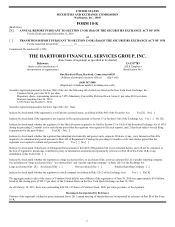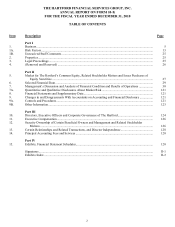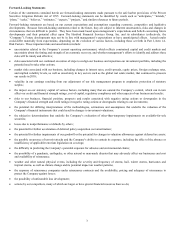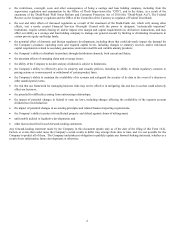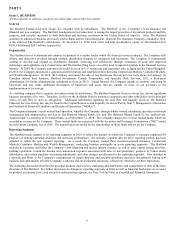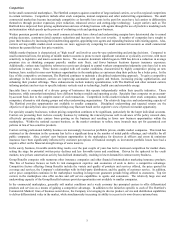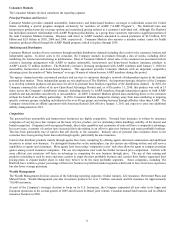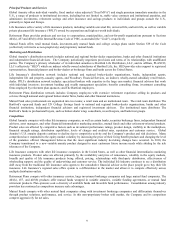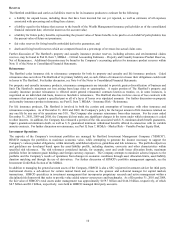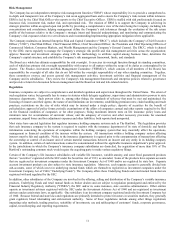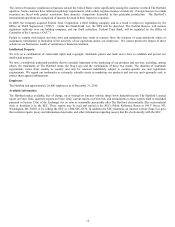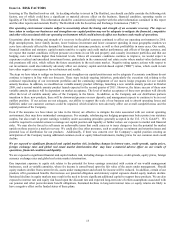The Hartford 2010 Annual Report Download - page 3
Download and view the complete annual report
Please find page 3 of the 2010 The Hartford annual report below. You can navigate through the pages in the report by either clicking on the pages listed below, or by using the keyword search tool below to find specific information within the annual report. 3
Forward-Looking Statements
Certain of the statements contained herein are forward-looking statements made pursuant to the safe harbor provisions of the Private
Securities Litigation Reform Act of 1995. Forward-looking statements can be identified by words such as “anticipates,” “intends,”
“plans,” “seeks,” “believes,” “estimates,” “expects,” “projects,” and similar references to future periods.
Forward-looking statements are based on our current expectations and assumptions regarding economic, competitive and legislative
developments. Because forward-looking statements relate to the future, they are subject to inherent uncertainties, risks and changes in
circumstances that are difficult to predict. They have been made based upon management’ s expectations and beliefs concerning future
developments and their potential effect upon The Hartford Financial Services Group, Inc. and its subsidiaries (collectively, the
“Company”). Future developments may not be in line with management’ s expectations or have unanticipated effects. Actual results
could differ materially from expectations, depending on the evolution of various factors, including those set forth in Part I, Item 1A.
Risk Factors. These important risks and uncertainties include:
• uncertainties related to the Company’ s current operating environment, which reflects constrained capital and credit markets and
uncertainty about the timing and strength of an economic recovery, and whether management’ s efforts to identify and address these
risks will be timely and effective;
• risks associated with our continued execution of steps to realign our business and reposition our investment portfolio, including the
potential need to take other actions;
• market risks associated with our business, including changes in interest rates, credit spreads, equity prices, foreign exchange rates,
and implied volatility levels, as well as uncertainty in key sectors such as the global real estate market, that continued to pressure
our results in 2010;
• volatility in our earnings resulting from our adjustment of our risk management program to emphasize protection of statutory
surplus;
• the impact on our statutory capital of various factors, including many that are outside the Company’ s control, which can in turn
affect our credit and financial strength ratings, cost of capital, regulatory compliance and other aspects of our business and results;
• risks to our business, financial position, prospects and results associated with negative rating actions or downgrades in the
Company’ s financial strength and credit ratings or negative rating actions or downgrades relating to our investments;
• the potential for differing interpretations of the methodologies, estimations and assumptions that underlie the valuation of the
Company’ s financial instruments that could result in changes to investment valuations;
• the subjective determinations that underlie the Company’ s evaluation of other-than-temporary impairments on available-for-sale
securities;
• losses due to nonperformance or defaults by others;
• the potential for further acceleration of deferred policy acquisition cost amortization;
• the potential for further impairments of our goodwill or the potential for changes in valuation allowances against deferred tax assets;
• the possible occurrence of terrorist attacks and the Company’ s ability to contain its exposure, including the effect of the absence or
insufficiency of applicable terrorism legislation on coverage;
• the difficulty in predicting the Company’ s potential exposure for asbestos and environmental claims;
• the possibility of a pandemic, earthquake, or other natural or man-made disaster that may adversely affect our businesses and cost
and availability of reinsurance;
• weather and other natural physical events, including the severity and frequency of storms, hail, winter storms, hurricanes and
tropical storms, as well as climate change and its potential impact on weather patterns;
• the response of reinsurance companies under reinsurance contracts and the availability, pricing and adequacy of reinsurance to
protect the Company against losses;
• the possibility of unfavorable loss development;
• actions by our competitors, many of which are larger or have greater financial resources than we do;

